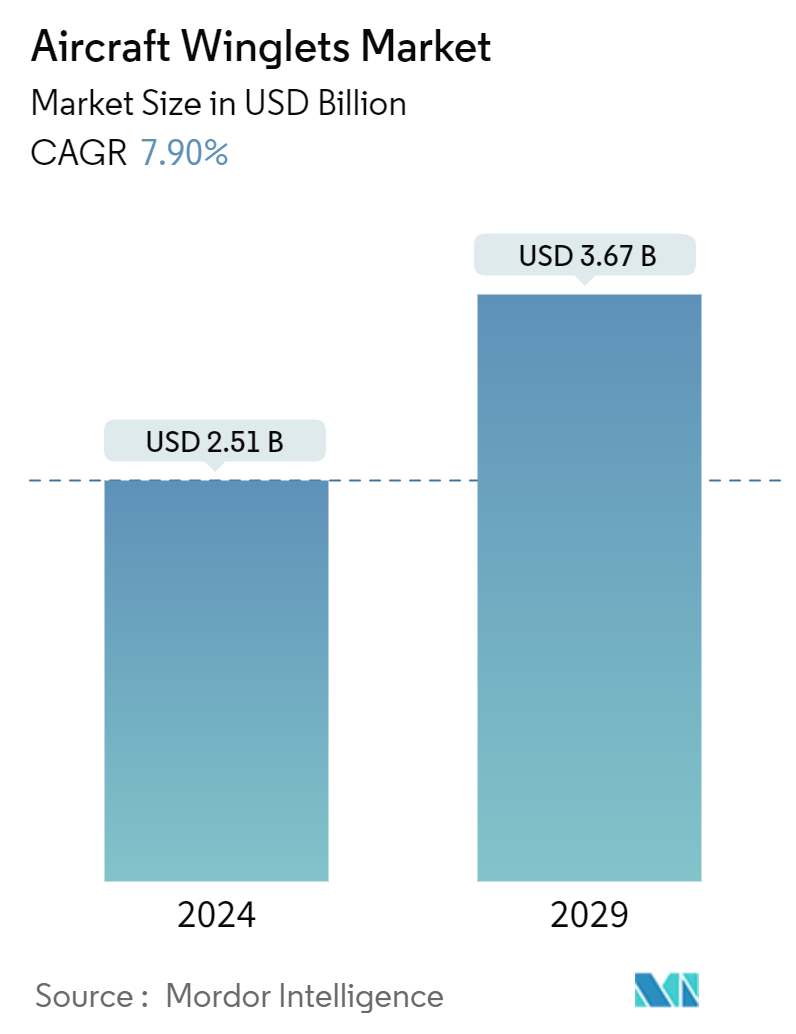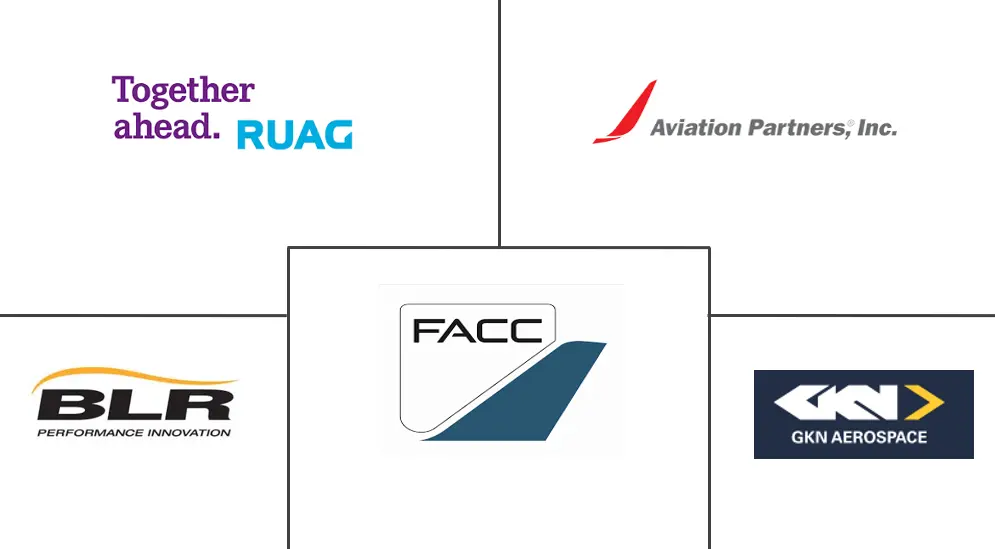Market Size of Aircraft Winglets Industry

| Study Period | 2019 - 2029 |
| Market Size (2024) | USD 2.51 Billion |
| Market Size (2029) | USD 3.67 Billion |
| CAGR (2024 - 2029) | 7.90 % |
| Fastest Growing Market | North America |
| Largest Market | North America |
| Market Concentration | Medium |
Major Players
*Disclaimer: Major Players sorted in no particular order |
Aircraft Winglets Market Analysis
The Aircraft Winglets Market size is estimated at USD 2.51 billion in 2024, and is expected to reach USD 3.67 billion by 2029, growing at a CAGR of 7.90% during the forecast period (2024-2029).
The aviation industry is witnessing a surge in adopting winglets and aerodynamic attachments on aircraft wings. These innovations are specifically engineered to boost performance and fuel efficiency. This uptick is primarily spurred by escalating fuel prices, compelling airlines to seek fuel-saving measures to curb expenses. Moreover, stringent environmental mandates propel the demand for sustainable solutions, aligning with the industry's objectives.
With the rising demand for long-haul flights, there is a heightened focus on fuel-efficient aircraft, notably those equipped with winglets. Airlines are incorporating winglets into new aircraft and retrofitting their existing fleets, underscoring a growing preference for these enhancements. Advancements in winglet design and materials continuously amplify performance gains, further bolstered by retrofit initiatives broadening the market's scope. The future of the winglet industry appears promising, buoyed by the emergence of eco-friendly aircraft, the surging global air travel demand, and a collective commitment to sustainability from both airlines and regulators.
Aircraft Winglets Industry Segmentation
Aircraft winglets or wingtip devices aim to enhance aircraft efficiency by minimizing drag. Winglets reduce lift-induced drag by mitigating wingtip vortices, enhancing the lift-to-drag ratio, boosting fuel efficiency for powered aircraft, and elevating cross-country speeds for gliders, ultimately extending their range.
The aircraft winglets market is segmented by type, end use, and geography. By type, it is segmented into sharklets, split scimitar winglets, wingtip fences, and blended winglets. By end-use, the market is segmented into commercial, military, and general aviation. The report also covers the market sizes and forecasts for the aircraft winglets market in major countries across different regions. For each segment, the market size and forecast are provided in terms of value (USD).
| By Type | |
| Sharklets | |
| Split Scimitar Winglets | |
| Wingtip Fences | |
| Blended Winglets |
| By End Use | |
| Commercial Aviation | |
| Military Aviation | |
| General Aviation |
| Geography | |||||||
| |||||||
| |||||||
| |||||||
| |||||||
|
Aircraft Winglets Market Size Summary
The aircraft winglets market is experiencing significant growth, driven by the aviation industry's increasing focus on enhancing performance and fuel efficiency. This trend is largely influenced by rising fuel costs and stringent environmental regulations, prompting airlines to adopt winglets and other aerodynamic attachments. The demand for fuel-efficient aircraft, particularly for long-haul flights, is on the rise, with airlines retrofitting existing fleets and incorporating winglets into new aircraft. Advancements in winglet design and materials are further enhancing performance, while retrofit initiatives are expanding the market's reach. The industry's future looks promising, supported by the development of eco-friendly aircraft and a global increase in air travel demand, alongside a shared commitment to sustainability from airlines and regulators.
The North American aircraft winglets market is expanding due to increased cargo traffic, a growing number of airports, and heightened investments in the aviation sector. The rapid expansion of the aviation industry and urbanization are driving demand for new aircraft, which in turn supports market growth. US-based airlines are expanding their fleets and route networks, with significant aircraft deliveries from major manufacturers like Airbus and Boeing. Additionally, the United States is focusing on enhancing its military fleet, with increased defense spending aimed at modernizing military systems. The market is characterized by a fragmented landscape with numerous players, including Aviation Partners, Inc., BLR Aerospace, FACC AG, GKN PLC, and RUAG AG, all competing for market share and leveraging advanced technologies to improve fuel efficiency and reduce operational costs.
Aircraft Winglets Market Size - Table of Contents
-
1. MARKET DYNAMICS
-
1.1 Market Overview
-
1.2 Market Drivers
-
1.3 Market Restraints
-
1.4 Porter's Five Forces Analysis
-
1.4.1 Threat of New Entrants
-
1.4.2 Bargaining Power of Buyers/Consumers
-
1.4.3 Bargaining Power of Suppliers
-
1.4.4 Threat of Substitute Products
-
1.4.5 Intensity of Competitive Rivalry
-
-
-
2. MARKET SEGMENTATION
-
2.1 By Type
-
2.1.1 Sharklets
-
2.1.2 Split Scimitar Winglets
-
2.1.3 Wingtip Fences
-
2.1.4 Blended Winglets
-
-
2.2 By End Use
-
2.2.1 Commercial Aviation
-
2.2.2 Military Aviation
-
2.2.3 General Aviation
-
-
2.3 Geography
-
2.3.1 North America
-
2.3.1.1 United States
-
2.3.1.2 Canada
-
-
2.3.2 Europe
-
2.3.2.1 Germany
-
2.3.2.2 United Kingdom
-
2.3.2.3 Russia
-
2.3.2.4 France
-
2.3.2.5 Rest of Europe
-
-
2.3.3 Asia-Pacific
-
2.3.3.1 India
-
2.3.3.2 China
-
2.3.3.3 Japan
-
2.3.3.4 South Korea
-
2.3.3.5 Rest of Asia-Pacific
-
-
2.3.4 Latin America
-
2.3.4.1 Brazil
-
2.3.4.2 Rest of Latin America
-
-
2.3.5 Middle East and Africa
-
2.3.5.1 United Arab Emirates
-
2.3.5.2 Saudi Arabia
-
2.3.5.3 Rest of Middle East and Africa
-
-
-
Aircraft Winglets Market Size FAQs
How big is the Aircraft Winglets Market?
The Aircraft Winglets Market size is expected to reach USD 2.51 billion in 2024 and grow at a CAGR of 7.90% to reach USD 3.67 billion by 2029.
What is the current Aircraft Winglets Market size?
In 2024, the Aircraft Winglets Market size is expected to reach USD 2.51 billion.

